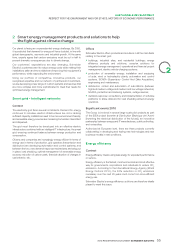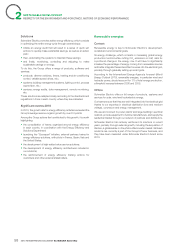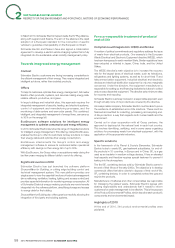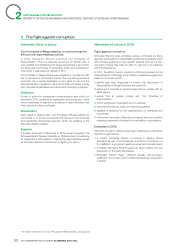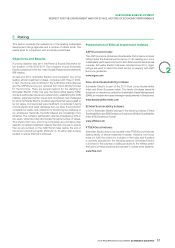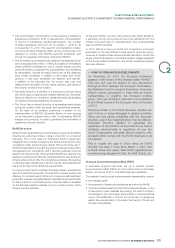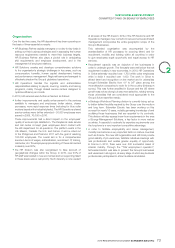APC 2010 Annual Report Download - page 67
Download and view the complete annual report
Please find page 67 of the 2010 APC annual report below. You can navigate through the pages in the report by either clicking on the pages listed below, or by using the keyword search tool below to find specific information within the annual report.
SUSTAINABLE DEVELOPMENT
SCHNEIDER ELECTRIC’S COMMITMENT TOENVIRONMENTAL PERFORMANCE
The CDP publishes a score for transparency in companies’
communication regarding their strategy to combat climate change
(Carbon Disclosure Leadership Index – CDLI) and, since 2010, it has
included a score for the integration of climate change challenges
into the Company’s strategy and activities in this area (Carbon
Performance Leadership Index – CPLI).
•Schneider Electric’s score on the CDLI (out of 100) has fallen
continuously over the last three years. In its action plan, the Group
has prioritised the signifi cant reduction of carbon emissions within
a defi ned scope (scope1 and 2 as defi ned in the GHG Protocol
and a small part of scope3), perhaps to the detriment of extensive
reporting work on scope3 of the GHG Protocol: measurement
of emissions from transport and purchases, measurement of
the carbon impact of our green services and products for our
customers, measurement of our emissions by activity or Group
entity. The requirements of the CDP increase from one year to the
next, while the number of companies publishing information on
their carbon programs also increases.
•The Carbon Disclosure Leadership Index assesses the quality
of the strategy, governance, communication with stakeholders
and actions related to climate change on an A (maximum) to D
(minimum) scale. Only businesses that score over50 on the CDLI
can feature on the CPLI. The B score is attributed to businesses
which “are rapidly adapting”.
For further information see www.cdproject.net
Main Plans of Action in 2010
Actions to reduce emissions at the Group’s sites (SF6
gas + energy consumption)
To fulfi ll the objective of the Planet & Society Barometer to reduce
our emissions of CO2 equivalent by 30,000 tons per year, we must
reduce industrial SF6 gas leaks to a rate of 1.2% of gas bought
(the objective for 2011 is to further reduce this to 1%) and energy
consumption in our sites by 4% per year and per employee between
2009 and 2011. To this end, the following actions were conducted
in 2010:
•specifi c objectives to reduce the carbon footprint for the Schneider
Electric industrial scope were defi ned and taken into account to
calculate the variable share of the salary of all employees involved
in industrial operations who received a bonus;
•monthly reporting of the indicators for the reduction of the
industrial carbon footprint for all sites concerned, compared with
twice yearly in previous years. The carbon footprint of scopes1
and2, as defi ned in the GHG Protocol, is calculated monthly, as
is the performance of each site concerned;
•since2010, the carbon performance has been presented monthly
to the Management of the Industrial Operations Management by
the Group’s Environmental Director and the three SERE Directors;
•a Failure Modes, Effects and Criticality Analysis (FMECA) has
been deployed for manufacturing processes that involve SF6gas;
•the Energy Action program, which included the deployment of
the EEM system (Energy Effi ciency Monitoring) in more energy
intensive sites, was implemented in2010 (see pages 66-67).
Actions to reduce emissions linked to freight
Actions were conducted in 2010 to reduce the proportion of air
freight in long distance freight to 20% between 2009 and 2011 :
•the scope of monitoring of tons transported by long distance
freight was extended to 76% (compared to 40% in 2009).
•the importance of the reduction of CO2 emissions was the
subject of an awareness campaign among the Group’s transport
community. Work is being carried out with the suppliers to
prepare a global carbon assessment of transport in 2011.
•the respective proportions of air and sea freight are monitored
monthly by the Global Supply Chain Management.
•the key managers of the supply chain receive a share of their
annual bonus based on the fulfi llment of objectives for air/sea
freight ratios.
Despite a 40% increase in long-distance fl ows due to localised
problems of a shortage of electronic components worldwide, the
share of tons transported by air remained stable at 20%.
Goods transportation is the second largest source of CO2 emissions
at Schneider Electric (37% of CO2 emissions based on the
Company’s 2006 carbon assessment).
In addition to the Company’s actions to fulfi ll the objective of the
One program, 2010 also saw other commitments and actions to
extend measurements and reduce emissions of CO2 linked to the
transportation of goods and prepare the next company program
beyond 2011.
Two signifi cant commitments were undertaken in 2010:
•the systematic evaluation of the CO2 impact linked to transport
for all designs to modify industrial infrastructures;
•the systematic evaluation of the Group’s capacity to measure CO2
emissions linked to transport when auditing our logistics sites.
In addition, the constant streamlining of logistics, which helps
reduce CO2 emissions due to goods transportation continued to
provide a focus within the Schneider Electric entities in 2010. The
various actions conducted included the following: the closure of 10
distribution centers, the identifi cation and constant simplifi cation of
complex historical fl ows linking several levels of stock in our supply
chain, the transfer of the regional distribution center for the Asia
Pacifi c zone from Hong Kong to Singapore, the barycenter for our
international fl ows in the zone, and the consolidation of fl ows from
different activities in the same city and under the same roof when
this makes sense.
2010 REGISTRATION DOCUMENT SCHNEIDER ELECTRIC 65
2


